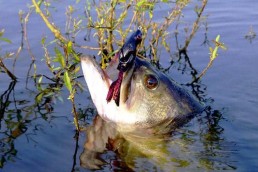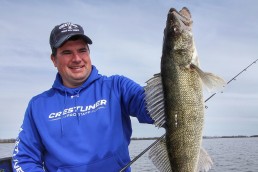Mining the Depths: Power of Pulling Leadcore
SHARE THIS POST
From a very early age, I started trolling crankbaits. Growing up, my favorite crankbait was an 11-S floating Rapala. This black and silver floating crank would catch so many fish that the balsa wood would get destroyed and only the wire holding the three treble hooks together held the lure together. My rod and reel setup was a Mitchell 300 spinning reel, spooled with 10-pound-test Stren or Trilene monofilament, and a Kodiak rod. Since those early days of trolling in a 14-foot aluminum boat with a 6-hp Johnson, my choice of equipment has evolved.
I still like to troll, but let’s just say, things have changed, and for the better. Instead of limiting my trolling to shallow water—with the advancements in rods, reels, lures and leadcore line—I now troll in depths in excess of 40 feet. Imagine being able to put your most effective crankbaits in front of walleyes in 32 feet of water while covering a lot of water. If you like catching walleyes, trolling crankbaits using leadcore is very effective and easy to learn.
Rods, reels and line, the basics
In today’s age, it is nothing to stop by a sporting goods retailer and find a good leadcore rod and reel combo already spooled with line for around $100. An angler can certainly buy a high-end setup, but to get in the game of leadcore trolling, it doesn’t have to break the bank.
Make sure your reel has enough line capacity to hold 10 colors of lead. Each color is 10 yards, or 30 feet long. Since it’s a thicker diameter line due to the lead inside of its core, it does use up some space on the spool.
I prefer spooling leadcore line on a line counter reel. You can count colors and stay dialed into your desired depth; however, line counters make the process less complicated.
There are a variety of brands of leadcore line that will work to catch fish. There is one I am more partial to, and perhaps for some selfish reasons. Suffix 832 Advanced Leadcore dives 30% deeper than conventional leadcore. When you are letting out 150 feet of line at a time and constantly changing lures, checking lures for debris, or reeling in small fish, it takes 30% less reeling and letting out is very nice.
Connected to your leadcore line is a leader, either made up of a superline, mono or fluorocarbon. A clear line like mono or fluoro might be necessary in clearer water. I prefer a superline if possible, so I can see the action of the lure and when it fouls. The length of the leader is typically dependent upon how clear the water is. For Lake of the Woods with stained water, use about a 6-foot leader. On clearer waters, you may go with 12 to 15 feet. It is helpful to keep leader lengths consistent between rods. It ends up being helpful in matching depths when one rod starts catching fish.
You can connect the leader by using a small swivel or by tying a special knot, such as a Willis, Albright or a blood knot. The internet is a great resource to learn how to tie these knots if you are not familiar. On the lure end of the leader, add a tie on a snap and you are ready.
On the water
Once your favorite crankbait is attached, begin to let line out. Leadcore doesn’t cast very well. Don’t free-spool while letting out, since your line can backlash and tangle. Thumb the spool while the lure goes back.
In determining how much line to let out, you need to have an idea of how deep your crankbait dives. If we are fishing in 30 feet of water and our crankbait goes down 8 feet, we need 21 feet more of depth to get a foot off of the bottom.
The rule of thumb with leadcore is 5 feet of depth is gained for every color (10 yards) of line at about 2 mph. To get down that extra 21 feet, you need about four colors of line. Forty yards is 120 feet on the line counter reel. Less line out is required when using advanced leadcore.
Are you enjoying this post?
You can be among the first to get the latest info on where to go, what to use and how to use it!
When fishing walleyes on the bottom, I let out increments of 10 feet more of line until my lure starts to hit bottom. You can tell the lure is hitting bottom when the rod jerks or bounces. I make a mental note of how many feet that is and reel up 10 feet of line.
Mix it up
Once trolling, if you are able to have more than one line out, experiment. Try different lures—different brands, sizes, wobbles, colors, big billed, little billed, jointed, floating, neutral buoyancy, etc.
Figure out what the walleyes want by putting the lures right in front of the fish, hitting the bottom or by trolling the lure above them so they have to swim up to eat. Every day can be different.
Try different speeds. From very slow to over 3 mph really allows you to see what the fish want. Take the rod out of the rod holder and pump it. Zip it forward and let it fall back. On a recent trip fishing Lake of the Woods, the boat I was fishing in did not have rod holders. This forced me to hold the rod. Of course, I started experimenting. That particular day I noticed when I let the lure drop back, they nailed it. When I did nothing, we caught fewer fish. Our fish catch that day would have been cut by 50% if we had the rods in holders.
While fishing a tournament on the same lake, we were marking walleye after walleye and could not get them to go. I was trolling at 2.3 mph and reeling in to check my lure. About a third of the way in, I got hit by a nice walleye. My partner, after seeing what happened, started to reel in and was also hit by another nice walleye. For the rest of the day, as the expression goes with experienced trollers, “I drove like a drunken sailor”—slowing down, gunning the motor and speeding up, sharp turns. These maneuvers have a big effect on the action of the lures, and that day it proved to be successful.
Lake of the Woods is a fun lake to pull leadcore. In the summer, hundreds of thousands of walleyes will set up in the basin, which for the most part, is flat mud at about 32 feet deep. The fish primarily hug the bottom. You can troll for miles and catch walleyes and saugers. Pulling lead in this scenario is a lot of fun. It’s a great place to learn since there isn’t much structure or snags, and typically, you will have a good level of success.
Once you hook up with a walleye, keep your rod tip up at about 2 o’clock. Let the rod do its job. Don’t pump and reel, but rather, reel in steadily. I prefer a looser drag so when the fish runs, it can easily pull out line. When fishing tournaments, every fish matters. If a walleye starts to ski across the top of the water, we keep that fish coming in at that consistent speed, hopefully right into the net. It seems, in most cases, when walleyes are skimming across the top, if you maintain that speed and they don’t hit a big wave, they usually cooperate. This won’t work on bigger fish.
For anglers who have not used leadcore before, it may be intimidating, but it doesn’t have to be. You can have a good level of success while starting out. Like anything, every time you use leadcore, it will help you become more familiar and confident with it. If you are a walleye angler, this is one tool you will want to have in your walleye fishing tool belt.
A good line counter reel is helpful when dialing in walleyes. Holding the rod vs. keeping it in the rod holder allows for zipping the crankbait forward and dropping it back, often triggering strikes.
In the summer, some charter boats on Lake of the Woods will get crankbaits down deep using downriggers. Although very effective, downriggers on your own boat isn’t realistic for many, thus leadcore is a reasonable and effective solution.
MWO
SHARE THIS POST
Did you enjoy this post?
You can be among the first to get the latest info on where to go, what to use and how to use it!
Joe Henry
Tournament angler and licensed charter captain Joe Henry fishes and hunts the Midwest. Henry is a media member of AGLOW and writes for numerous publications, creates videos, appears on a variety of outdoor TV and radio shows and is a frequent seminar speaker. Henry is the Executive Director of Lake of the Woods Tourism.



